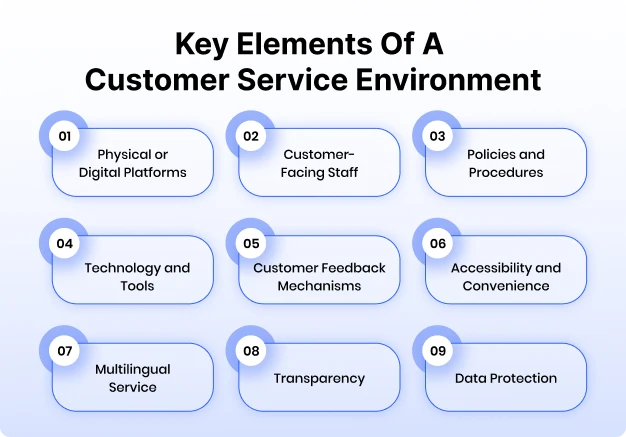 Customer Service
Customer Service

02 May, 2024

Customer service is a way of marketing by emotionally influencing your customer base. Customer experience generates an annual revenue gain of $823 million for 3 years for a $1 billion revenue company. Within this system, you need to provide your clients assistance both before and after they purchase goods or services.
If you want to satisfy your customers, you must learn what a customer service environment is and why it is important for your business. Maintaining proper communication with the customers and providing them with complete assistance are the keys to creating a positive customer service environment.
Throughout this article, we will give you an idea about various factors of the customer service environment. Thus, tag along with us till the end.
Contents
A customer service environment refers to the overall context of gaining the customers’ trust. It’s a setting within which the interactions between customers and service providers take place. Any positive customer service environment includes easy accessibility, proper communications, assistance, problem-solving opportunities, transparency, data confidentiality, and customer feedback.
For instance, when a customer calls a tech support hotline, the call center itself is the physical environment. Here, the customer representative has access to necessary information and technical resources. In an ideal customer service environment, a patient and knowledgeable representative will clearly explain solutions and resolve the issue efficiently.
Generally, a positive customer service environment encompasses the following elements and factors that contribute to the overall customer experience:

The physical space where customer interactions occur, such as retail stores, service centers, offices, or online platforms. As customer service environments have extended to online platforms, interaction occurs through different customer service channels.
A few examples of these service channels are websites, mobile apps, social media, email, and other digital channels.
They are frontline employees who are in charge of directly interacting with your customers first. You can also call the customer service representatives.
They will listen to customer’s inquiries, provide assistance, and resolve issues. Besides, their excellent communication skills help in providing customers with knowledge about your goods.
A customer service environment also includes established rules, protocols, and procedures that guide customer interactions. On the product website, you may provide information, including free trial, return policies, warranty information, and service protocols.
The use of technology and tools to facilitate customer interactions and efficient interactions among the support agents. With the help of technology and tools, they can keep track of the initial to final status of your complaints.
A few common tools and technologies are customer relationship management (CRM) systems, ticketing systems, communication platforms, etc.
Furthermore, you may keep investing in your customer service environment without getting the expected benefits. That’s why, keep track of the cost and benefits of the service using tools like cost-benefit analysis(CBA)
Customer feedback is necessary to identify and track any problems with the service or products. The feedback will help you to analyze poor goods and specific issues with the products.
Then, you can conduct quality checks of your product and eventually audit the supply chain. That’s why you must provide different feedback mechanisms, including surveys, reviews, and customer satisfaction scores.
A few examples of a great customer service environment are easy access to information, making inquiries, and receiving support. Access to the information can be through online self-service options or direct assistance from customer service representatives.
To help your customers, you can set up a chatbot, FAQs, podcast videos, and informative pages on the webpage.
Multilingual support can attract customers across the globe and improve your interactions with customers. When you encounter a customer who isn’t good at English, the multilingual setting will save you. Besides, interacting with potential customers in their native language eliminates the barrier of miscommunications.
You must maintain integrity and honesty in your customer service before and after selling your service. Ensure you provide accurate information about the product details and delivery time. Some rules function to protect the rights of your customers:
If you fail to comply with these acts, then you may have to encounter imprisonment or fines.
Selling data is a big business nowadays. If you purchase a health tracker online, platforms will immediately start to show you ads for protein shakes.
Although most of your customers are ignorant of this matter, your service environment needs to be responsible. According to the Consumer Privacy Act, you can collect their data with their permission.
Also, those data should be protected from unauthorized parties and no extra charge should be taken for that. In the USA, these Acts are known as CCPA, VCDPA, and ColoPA.
Creating a positive customer service environment is essential to retain the customers’ loyalty, and enhance the profitability of the company. For that, ensure the following criteria:
It will be displeasing for you if you call the customer service center and they behave rudely with you. To keep up with customer satisfaction, being empathetic and patient with the customers is necessary.
However, in a fast-paced and high-volume environment, representatives need to interact with a lot of customers continuously. This may cause a loss of effectiveness and patience.
That’s why training programs are essential for them so that they can cope with a fast-paced high-volume environment. Moreover, it’s necessary to enhance their skills, product knowledge, and communication abilities to improve the service profit chain. Remember, customer satisfaction and loyalty are directly linked with the revenue growth of your company.
To create a brand image, you need to create a perception of the service quality of your company. This helps customers believe and trust in your goods to fulfill their goals.
Therefore, ensure quality products and emphasize them to your customers. Because a positive impression of your goods will give your brand identity to the potential customers. On the contrary, poor service can cause a negative brand image and you will lose your customers.
The representative has to be friendly, and respectful towards the customer to make them feel comfortable. Those staff must have to be polite and good listeners.

You need to provide relevant solutions to the customer depending on their needs. Different customers will come to you with their various types of inquiries. In this case, you must have the ability to adjust to their inquiries and meet their needs.
Nowadays automated voice and conversation are common in customer service. Though it reduces the costs and required time, no emotional attachment will be created.
Treating each customer as an individual and personalizing interactions based on their preferences will make them feel special. Your personality and emotions will create a memorable customer experience for them.
In this case, you can utilize a live chat or help desk software to allow your customers to get help right where they need it. This eliminates the hassle of waiting on hold for phone calls or lengthy email exchanges.
Ensure consistency in customer service delivery across all communication channels and touchpoints. Employ phone and email support, knowledge base, self-service portals, live chats, etc. Thus, maintain the protocols, policies, deadlines, promises, and transparency, to build trust among the customers.
To make your customers special, express your gratitude appropriately. You can provide them with rewards, discounts, and free trials. Importantly, be respectful towards all the employees in this customer service environment.
If the employees are stressed, they may not interact effectively and appropriately with your customers.
Before knowing what a customer service environment is, first know that customers are at the center of this. Thus, the main goal of providing a good customer service environment is to gain the customers’ satisfaction and loyalty.
Generally, the capabilities of the service representatives and communication channels help in retaining your customers’ loyalty. Uses of live chat software, self-service portals, help desk software, etc., improve personalization and facilitate faster issue resolution.
Maintaining a good customer service environment involves taking feedback from customers. Depending on the feedback you need to track the failures in your service and solve those.
See also: How Does Employee Engagement Affect Customer Satisfaction?